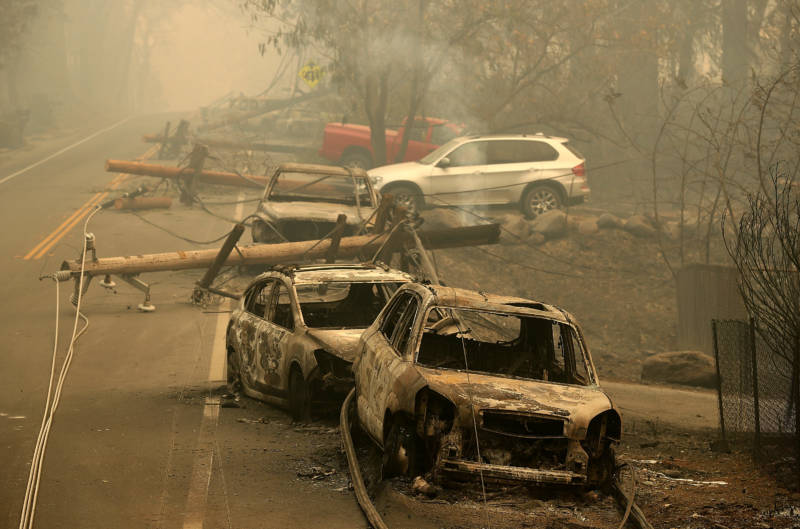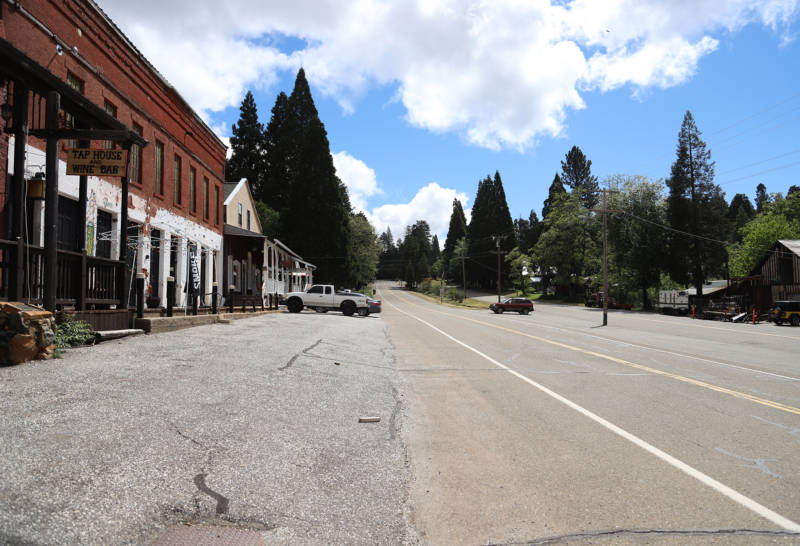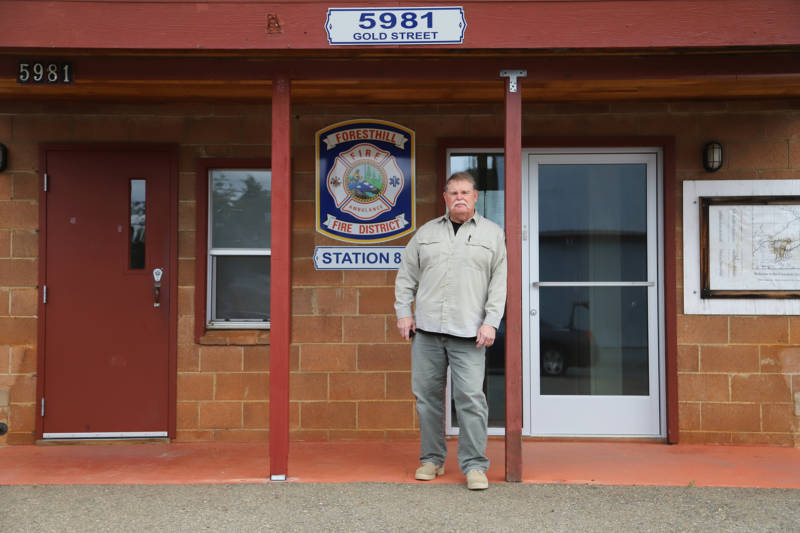Foresthill Road, which extends from Interstate 80 deep into the Tahoe National Forest, is a beautiful drive. Well-paved and scenic, it takes you across the North Fork American River over the breathtaking Foresthill Bridge, one of the tallest spans in the country. As you move farther from the highway and closer to the Sierra Nevada Foothills, it’s the density of the growing number of trees lining each side of the roadway that claims your attention.
In the Age of Fast-Moving Fires, What's the Best Way to Get People Out?

The road’s 5-star TripAdvisor rating makes sense; it’s the kind of drive you take for fun.
Yet, it’s also the source of considerable anxiety for Foresthill, a community of around 1,500 residents. That’s because there’s only a single main route in and out of town, and Foresthill Road, with one narrow lane going and one narrow lane coming, is it.
A Potential Disaster
During a wildfire, you could imagine, the roads would clutter with the cars of panicking people all trying to make it out of town one step ahead of the flames.
That’s something Gary Kirk thinks about. A lot.
“A single ingress-egress is not good for a community,” said Kirk, a volunteer firefighter for decades who worked his way up to captain at the Foresthill Fire Protection District. He’s retired now and spends his time as director of the Foresthill Fire Safe Council, a nonprofit group working to keep residents prepared for wildfires.
He knows this community inside and out — what makes it prone to wildfire danger and what makes it a beautiful place to live. He’s hunted and fished in the area for years, and he loves living in the forest. But in the event of a wildfire, he said, Foresthill Road could be disastrous.
“I know Paradise. I’ve been there several times. And Skyway was just like Foresthill Road,” he said, referring to the main route out of the town that last year became synonymous with lethal California fires.
Compared to Paradise, according to a USA Today-California Network analysis of wildfire evacuation routes, Foresthill actually has a worse population-to-lane ratio.
Kirk’s not the only one who worries.
“I think it’s a big concern for most of the people here,” said Shonne Elgin, a resident since 1989.

‘The Fire Was Outrunning Us’
When the Camp Fire swept through Paradise in November 2018, residents took to Skyway en masse, and 27,000 people, with flames bearing down, were caught in gridlock. Some residents abandoned their cars to flee on foot. Others were found dead in their vehicles. For some who made it out, it took up to 10 hours to get to an evacuation center.
“The fire was outrunning us, in terms of our ability to notify people, get evacuations done, before we even knew we were in a race.” Butte County Sheriff Kory Honea told KQED in the aftermath of the catastrophe.
“Are there better ways to notify people? Are there better ways to conduct evacuations? Those are all things that I want to look at, perhaps have studies done, to determine if there are lessons to be learned.”
Still, Honea said, nothing could have prepared Butte County and Paradise for the disaster of the Camp Fire. The town and county indeed had an evacuation plan, one that included dividing the town into 14 zones, the creation of assembly areas, and even a fire drill.
The systems that the county put in place helped to get tens of thousands of people to safety, Honea said, but they still couldn’t defend against the speed of the Camp Fire.
“Is the system perfect?” he said. “There’s no system that is ever perfect.”
Rethinking Evacuations
Many other towns living under the threat of wildfire don’t have a plan, perfect or not. A recent USA Today California Network survey found that just 22 percent of at-risk communities have robust evacuation plans available to the public.
Placer County, which would oversee an evacuation of Foresthill, is working on its own blueprint for leaving town during a wildfire, and officials hope to have it finished this summer. But it’s not necessarily one you might expect.
“A lot of people think that we’re going to come up with a specific evacuation route — that this is the way you have to go out. And that’s just not the case, because the fire’s going to predict how we’re going to do the evacuation,” said Ty Conners, a sergeant with the Placer County Sheriff’s Office, who works as the station commander for Colfax and Foresthill.
Conners was a first responder during the Camp Fire and saw for himself what happens when an entire community tries to leave on one road.
“They had a very good evacuation plan,” Conners said. “Only thing is, that fire was moving so fast that even if you have the best plan, you can’t beat the fire.”
Seeing the devastation in Butte County has caused Conners to re-examine town evacuations.
“Giving people an evacuation route, trying to get them out— yeah, it’s important,” he said. “But if you’re not going to be able to do it … divert people to these temporary safe refuge areas.”
The idea is that if you have a fast-moving fire and only one way out, residents would be directed to somewhere in town with defensible space and fewer trees, making it safe to take shelter.
In Foresthill, Conners said, that could be the local high school.
“The Foresthill High School has a huge area of clear-cut,” he said. “That’s a place that’s a temporary safe refuge for people to congregate and go while the actual fire front pushes through, and then you can evacuate them out.”
Simulating Disaster
Temporary refuge could indeed be the answer when there’s a fast-moving fire and limited escape routes, says Dapeng Li, an assistant professor of geography at South Dakota State University.
“There are many places we can use as the shelters,” Li said. “For example, places like high schools, where there are a lot of open spaces, or other facilities in town.”
Li studies wildfire evacuations by overlaying fire progression models with traffic simulations to see how incoming flames can influence exit plans, making them dynamic.
“We could use a traffic simulation model to estimate how much time we would need for the community to evacuate,” he said. “If we don’t have enough lead time, we might need to ask them to go to those shelters or to shelter in place.”
Using this modeling technique, Li said, a community can virtually explore an infinite number of evacuation scenarios when it comes to how a wildfire progresses. For example, officials might see what would happen when a fire is spreading from a particular direction and shutting down a specific portion of roadway.
“We can also do simulations [for] if we build a new evacuation route,” Li said. “That could be used for planning and transportation purposes.”
The idea is that if emergency managers were to model different wildfire situations, they could devise multiple plans from which to choose when disaster strikes.
California counties could make use of similar models in order to create contingency evacuation plans, Li said, but it would take time, resources and a lot of training.
“If we are to make an evacuation plan, we need to consider different scenarios,” he said.

It Starts With an Alert
Even if a community has foolproof and adaptable evacuation protocols in place, there’s still the matter of letting residents know there’s a wildfire.
During both the Camp Fire and the North Bay fires of 2017, county officials came under scrutiny for using so-called “opt-in” alert systems, which only sent emergency notifications to people if they’d signed up for the service.
In Butte County, that emergency system is called “Code Red.” In the aftermath of the Camp Fire, many residents told KQED they didn’t learn about the fire from officials, but rather through word of mouth, media reports, or actually seeing or smelling flames.
In March, the Governor’s Office of Emergency Services released statewide guidelines for counties on how to issue emergency alerts. The 85-page document suggests a number of ways communities can better prepare for disasters, including using Wireless Emergency Alerts, or WEA, a system run by the Federal Emergency Management Agency that allows geo-targeted notifications to be sent, much like an amber alert, to every cellphone in a given area.
The guidelines provide “consistency across all of our 58 counties and jurisdictions,” said Cal OES director Mark Ghilarducci. While the suggested protocols stop short of requiring use of WEA, Ghilarducci hopes they’ll push communities in the right direction.
“Without establishing a mandate, [we] recommend the use of WEA and the expectation [is] that all of the counties would use WEA,” he said. “And this guideline was put together as a collaborative effort with our local government partners, and every indication is that that will become the standard bearer in the state.”
Officials in Placer County are prepared to use WEA in the event of a devastating fire in Foresthill, according to Holly Powers, the county’s assistant director of emergency services.
“Our alerting protocol is across the board,” she said, noting that in some remote areas WEA may not be enough to reach every resident.
“Something that a lot of people may not realize is that WEA is based on cell towers and cell data,” Powers said. “So if you have a fire that burns down a cell tower, even if I sent a WEA alert, it’s not going to be able to go through.”
‘Be Prepared’
For isolated areas like Foresthill, where cell service could be an issue, it’s important for people to know one another and to stay informed, says Gary Kirk.
That’s where his Fire Safe Council comes in.
“This time of the year is when we start really ramping up to get this information out to people,” Kirk said. “We do hold meetings once a month, and we get the community together.”
There are also communities in the area certified by the National Fire Protection Association’s Firewise USA program, Kirk said. The program teaches wildfire preparedness and fire safety initiatives, such as brush clearing. Kirk said these communities could potentially serve as temporary refuge during a fire.
Of course, the entire town isn’t showing up to Kirk’s monthly meetings. But the idea is that if you get some people informed, they’ll spread the word about what to do in the event of a fire, until eventually everyone is living and breathing fire safety.
“It’s a chain reaction that we try to create,” he said. “And it works.”
Still, for a community like Foresthill, there’s no real formula for an evacuation where everything goes just right. If you’re living in an isolated and fire-prone area, the most important thing is:
Always be ready.